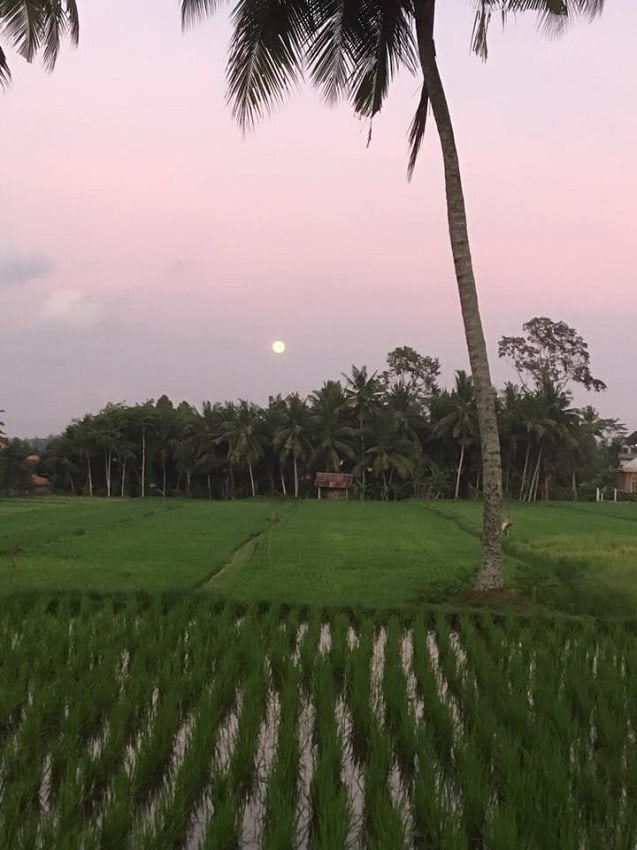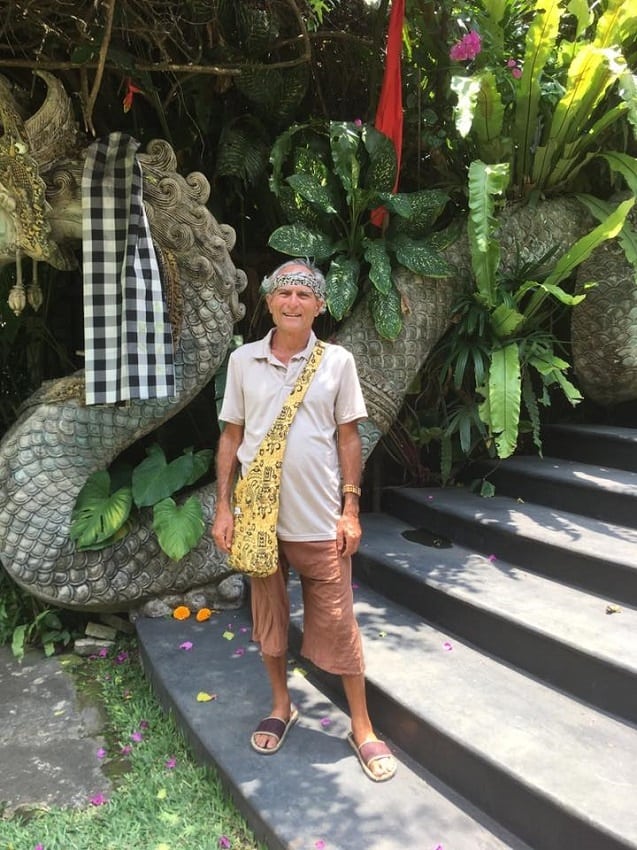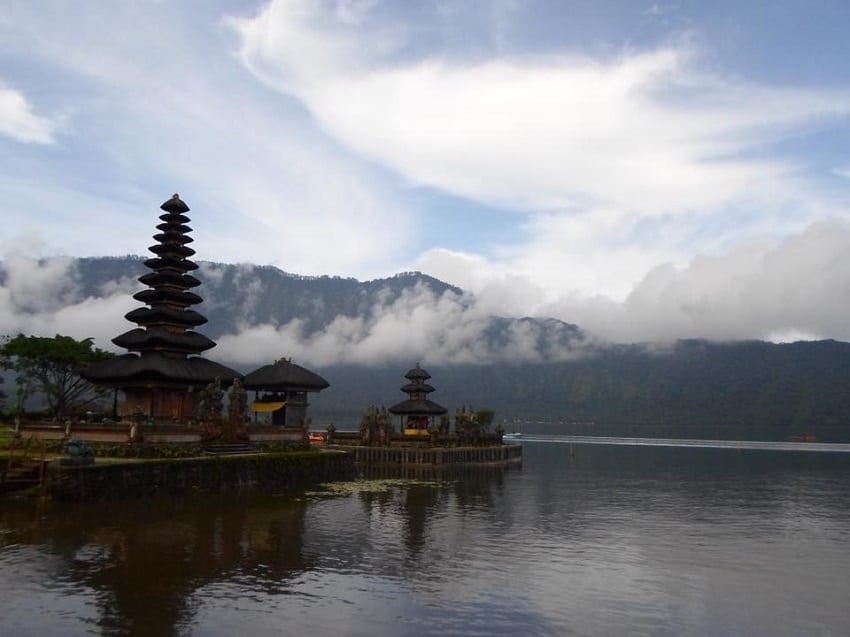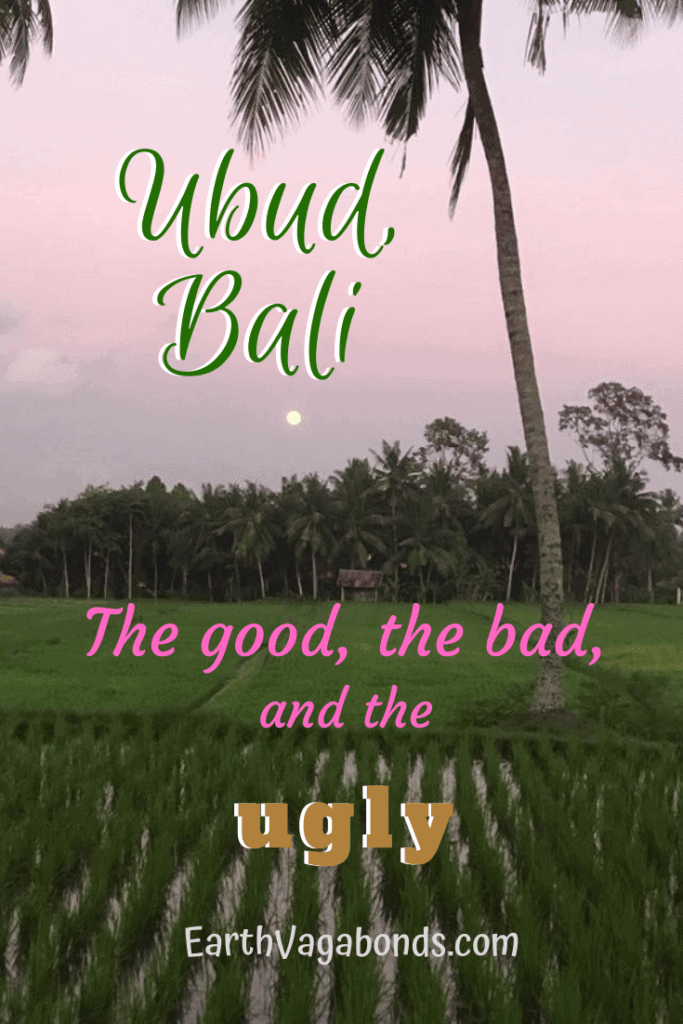Last Updated on June 8, 2023 by Ellen
Editor’s note: Earth Vagabonds arrived in Ubud, Bali, following a month-long stay on the north coast of the island in Lovina. We met our friend Chuck in Ubud, where he is staying for a month.
We immediately saw Ubud is vastly different from Lovina. There are thousands more tourists, souvenir shops and higher-end stores all over, so the vibe is a bit less authentic than our previous location.
But as Chuck points out, if you get beyond all of the modern overtourism issues, you still can find the real Bali. He should know: he’s been coming to Ubud for a decade. Chuck has some keen observations — something newbies like us couldn’t offer.
Below is an excerpt of a post Chuck wrote for our Facebook group (he is a group moderator). It’s republished here with permission. The pictures following the post are courtesy Chuck Burton, as well.
Why Ubud?
By Chuck Burton
It is difficult to know when Bali became a thing as its beauty and serenity have long been known in hip traveler circles. Indonesia has thousands of islands and others represent the same natural beauty without the crowds and modern commercialization. So what sets this place apart?
Whereas Indonesia is overwhelmingly a Muslim country, some accident of history made this island Hindu. And as a result it has its own architecture, traditions, culture and a very strong predilection for the arts both representational and performing and for aesthetic appreciation. Combine all that with its daring (to European sensibilities) custom of female toplessness, and Bali was a big draw to the artistic crowd even a century ago.
The naked breasts mainly disappeared from public view sometime around World War II. Some historians suggest that the women covered up in response to fear of marauding Japanese soldiers. In any case, the only shirtless women one is likely to see today are ancient grannies out in the fields and villages who never changed their ways, hardly a draw for male fantasy. The most prominent remnant of this “free” age can mainly be found in Ubud’s Blanco Museum. Antonio Blanco’s art is sometimes known as Breasts-a-Bali.
I happened to come upon a decrepit edition of the Lonely Planet circa the early nineties. Among other tidbits is the ironic discomfort of the locals with the scanty and provocative dress of the young, foreign female visitors. Is this a version of “what comes around, goes around?”
“The tension between locals and outsiders… has clearly existed here for some time.”
Another complaint of that time is that the tourists seemed to want to horn into every ritual and felt entitled to enter any building or household in their quest for authenticity. So the tension between locals and outsiders, naturally informed by equal parts of resentment ameliorated by the desire to make a living, has clearly existed here for quite some time.
It is hard to know when the age of mass tourism emerged, but the 1990s is a fair guess. Ubud, which possibly has more art per square meter than any other place on the planet, went from being a village without electricity and telephone service, to becoming a find. When a place becomes a find the early recipients of its paradisiacal status are wont to spread the word. And of course Paradise inevitably turns to Paradise Lost. And thus emerged modern New Age Ubud which grew in size and imagination as the place to go.
The trend was ever upward until the terrorist bombing in Kuta Beach in 2002 caused travelers to temporarily flee the isle and decimate the economy which unfortunately was increasingly dependent upon tourism. But memories are short, terrorism can and does strike anywhere and visitors returned with a vengeance. And of course I need to give a wry shout out to Elizabeth Gordon and her parody of modern self-absorption, Eat Pray Love, the final chapters set in Ubud. There are mobs of couples here seeking a honeymoon-type refuge. Otherwise I estimate the population of singles at a ratio of eight-to-one female-to-male, a flock of Julia Roberts wannabees.
“There are mobs of … Julia Roberts wannabees.”
I first came to Bali in 2010. I did some traveling around to see the sights, and just the same as so many others, discovered that Ubud was the place for me. I returned in 2012 and 2015, each time visiting for a month and always staying at a family guesthouse, my personal definition of paradise, where I am treated as one of that family. Every time I return, Ubud seems more crowded, full of bustle and more traffic and noise, home to more and more versions of the locals catering to the tastes of the young visitors with attractions which have nothing to do with the Balinese culture, fish eating away at your dead skin cells, gluten-free breads, veganism and whatever.
Arriving at the airport a few weeks ago was disorienting. There seemed to be so many incoming flights, the building seemed much bigger, the immigration line longer, the host of drivers with name-cards a throng. Traffic through the city and up into the hills was a mess, even on a Sunday afternoon.
As for Ubud center, it has turned into a caricature of itself. You can’t walk twenty feet without tripping over yoga studios, massage parlors, spas, non-dairy gelato parlors, vegan/gluten free restaurants, travel agents, motor scooters with their endless solicitation of taxi and transport, high-end boutiques, 7/11 style minimarts, Mexican restaurants, pizza joints and so on. The beautiful and graceful Balinese culture is buried beneath New Age glitz that has twisted its essence into a post-modern scam to monetize everything and anything and fleece the rampaging tourists. The sidewalks are swarming with the young, tattooed and beautiful and the narrow streets an endless succession of scooters. The place is a mercantile madhouse.
I feel particularly sorry for the very young travelers who are doubly cursed. They often have very little time and yet suffer from a sense of urgency to see everything. So they come to Ubud for two or three days, then rush off to the Gilli islands and then onward to Lombok, a very well worn pilgrimage. Two or three days in Ubud does not scratch the surface, they often stay in the center partying and maybe see a tourist “attraction” which says nothing about the real Bali. I learned a long time ago that I would never see everything and that the faster you go, the less you see. I always try to travel slowly and value quality over quantity. Everyone has to learn this for themself.
“I learned… the faster you go, the less you see.”
The Ubud that once drew seekers after art, beauty, serenity and all the gorgeous Hindu/Balinese temples and architecture is dead and buried. The ascendency of modern tourism is complete. The place is totally wrecked and the epidemic is spreading itself through the entire island. The signs for yoga and vegan cuisine have tentacles on the narrow byways that fan out into the countryside.
Except. Except. That is the bad news. The good news is that the beauty and serenity, the old architecture, the temples and sculpture, the emerald green paddy, the gracious and smiling Balinese people, the clouds and sun playing with the volcanoes at dawn and dusk, the lovely classical music, incense, ducks and birds, geckos and cicadas, vibrant, colorful paintings, exuberant flowers and vegetation, rice-field restaurants with simple and beautiful lines, lovely views and cuisine replete with the spices and odors of all the fresh and zesty tropical ingredients. It is all still here. Ubud and Bali, the Ubud and Bali that people from all corners of the world are flocking to. It is still here. You just need to make the effort to find it.
I have a room with a terrace and spectacular views of nature and traditional architecture. It is dead quiet, no scooter or traffic noise, only breeze, birds, cicadas, geckos and frogs. The friendliness and service is a balm, the heavenly breakfast a joy after a long early morning hike in the fields and ridges amidst the cool air. And by the standards of what you would pay in Europe and North America it is absolutely dirt cheap. Yet it takes me only minutes to leave my Garden of Eden in order have an endless choice of delectable cuisine, a lovely hour-long traditional massage and all the culture one could ever want. I just need to walk.
My biggest daily problem is choosing where to eat with too many delightful choices to fathom at all price levels. There are tiny warungs where a bowl of fresh, hot vegetable soup or a plateful of fried bananas covered with shredded coconut and other toppings run for a dollar. At the other end is spectacular Locavore fusion cuisine where a full meal can set a couple back seventy (still cheap by European standards). In the other direction a few minutes of brisk walking take me out into a natural landscape of breathtaking beauty and serenity.
Away from the city, the people smile and greet you unfailingly instead of dismissing you as a horde of invaders as they perhaps should and would be well-justified in doing. Only your fellow foreigners ignore you, lost in their mobile phones and earbud music. They walk in a cone of invisibility, pretending that they don’t see you, that it is all their private preserve.
Ubud is not wrecked because it is unwreckable. It is eminently accessible with only minimal effort. All you have to do is walk. Hati-hati. Watch out for the surly village dogs. They bark and threaten and sneak behind you. But so far anyway, they do not bite. My life here is as close to paradise as any place I know.



Three pictures and post courtesy Chuck Burton.


